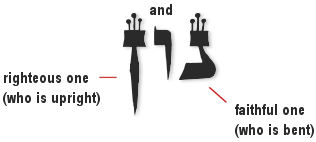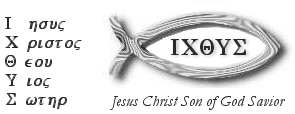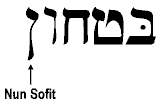|
|
 |
|
|
 |
 |
 |
 |
 |
 |
 |
 |
|
 |
 |
 |
 |
 |
 |
 |
 |
 |
|
Advanced Information
|
|
|
|
 |
|
|
|
The letter Nun is the 14th letter of the Aleph-Bet, having the numeric value of 50. The pictograph for Nun looks something like a seed, whereas the classical Hebrew script (Ketav Ashurit) is constructed of a bent Vav with a crown like a Zayin:

Nun is the third of the "double letters" in Hebrew, having both a "medial" form (kefufah) and an ending form (peshuta).
- The Mystery of Nun
According to the Chaz'l (sages), Nun is said to represent both faithfulness  and the reward for faithfulness. Moses is seen as the paradigmatic humble servant of the LORD. and the reward for faithfulness. Moses is seen as the paradigmatic humble servant of the LORD.
The word "Nun" itself is spelled Nun-Vav-(final)Nun and looks as follows:

Rashi said that this orthography suggests that the one who is humble before God will stand upright in the final day. In the olam hazeh (present life), this means that the tzaddik (righteous man) will simultaneously affirm: "I am nothing but dust," and "the world itself was made for my sake." Humble yourself in the sight of the LORD, and He shall lift you up (James 4:10).
- Yeshua and the Letter Nun
In Aramaic (the language of the Talmud), the word Nun means "fish," a symbol of activity and life. The first mention of the word is in Exodus 33:11, in reference to Joshua, the "son of Nun." Joshua, the one who succeeded Moses and was able to enter the Promised Land, was the "Son of Life" - a clear picture of Yeshua our Messiah.
Notice that the form of the Nun represents a bent Vav (suggesting a humbled man) crowned with glory (the three tagin on the head of the letter). From the Messianic point of view, we see that Yeshua came as a man (Vav), was honored by His absolute humility while upon earth (as indicated by the crown of thorns), and is now exalted as the Righteous One who wears the Golden Crown of God upon His head forever and ever (Rev 14:14).
- The Symbol of the Fish and Jesus
The symbol of the fish has early roots in Christianity as an emblem of the Messiah Yeshua. The word for fish in Greek is "ixthus," which some believe was used as an acronym for the Greek phrase Yesous Christos Theou Uios Soter, or "Jesus Christ the Son of God Savior":

- The Inverted Nun and the "Seven" Books of Moses
The Torah includes a textual oddity that warrants a close look from believers in the Mashiach Yeshua. An inverted Nun (Nun Hafuchah) appears both before and after Numbers 10:35-36:

And whenever the ark set out, Moses said, "Arise, O LORD, and let your enemies be scattered, and let those who hate you flee before you." And when it rested, he said, "Return, O LORD, to the ten thousand thousands of Israel." (Numbers 10:35-6)
|
|
|
 |
|
|
|
In the Talmud (Shabbat 115b, 116a) it is stated that any part of the Torah with 85 or more letters is itself considered a "book," and therefore, according to some of the Jewish sages, this passage of Scripture actually demarcates a separate book of the Torah! If so, instead of the five books of Moses, we would have seven:
1. Genesis
2. Exodus
3. Leviticus
4. Numbers (1:1-10:34)
5. Numbers (10:35-36) [set apart by the inverted Nuns]:

6. Numbers (10:37-ff)
7. Deuteronomy
Before Moses would lead the Israelites to a new station in the wilderness, he would order the ark to be moved by the Levites and then would chant "Arise, O LORD, and let your enemies be scattered, and let those who hate you flee before you!" When the Shechinah rested, Moses would stop the procession of the camp and chant, "Return, O LORD, to the ten thousand thousands of Israel."
However, on account of the "Sin of the Spies," Israel was refused entry into the Promised Land, and the "story" of what follows after Numbers 10:35-36 - namely, the outbreak of fiery judgment and the subsequent exile - was sadly written as history instead. What should have been written is that the LORD (as symbolized by the presence of the ark) entered the land with the redeemed Israelites on account of their faith in His promises. According to these sages, this part of the Torah is "yet to be written" and will be altered when the Messiah comes.
Why don't the Nun's face each other? According to the Talmud (Yoma 54a), the two Nuns picture the two keruvim (cherubs) which hovered over the Ark of the Covenant. When the Jewish people pleased God, the cherubs would face one another; if, however, they were disobedient, these angelic creatures would turn away from one another in the direction of the Holy Temple. Sin causes a rip in the fabric of spiritual reality, causing the angels of God (symbols of the Divine Presence) to turn away....
From a Messianic perspective, it is fascinating to see that what immediately preceeds this "book" is the story of Yitro (Jethro), Moses' Gentile father-in-law, who was offered to partake of the blessings of Israel. This is a perhaps a picture of the so-called "Church age" - i.e., the time when God would offer His salvation to the nations of the world (as represented by Jethro) just before a time of purging of national Israel. In other words, we can read this parenthetical "book" as a time of special dispensation for the nations of the world to turn to the "Son of Life" and be saved.
- Gematria of Nun
According to Jewish gematria, Nun represents the number 50 - a number representing freedom and fullness of life.
- 50 days from the Exodus to the giving of the Torah (50 days for the count of the Omer)
- 50 years for a Jubilee Year (yovel)
- 50 references to Exodus in the Torah
- 50 years of age before one has wisdom
- Nun represents Mashiach ben David
Nun is the fourteenth letter of the alphabet, which equals "David," the forefather of the Kingdom of Israel. The heir to David is Mashiach ben David, of whom is said: "As long as the duration of the sun his name shall rule":

May his name be eternal; while the sun lasts, may his name endure; let men invoke his blessedness upon themselves; let all nations count him happy. Psalm 72:17
The sages interpret the verb yinon in this verse to refer to the Messiah, and may be literally read as "may His Name Nun (propagate)."
Regarding the Mashiach Yeshua, one day all Israel will sing the final verses of Psalm 72 before Him and to the glory of the Father:
|
|
|
|
 |
|
|
|
Blessed be the LORD, the God of Israel, who alone does wondrous things.
Blessed be his glorious Name forever; may the whole earth be filled with his glory! Amen and Amen! (Psalm 72:18-19)
|
|
|
|
- Crowned Letters
In some Torah Scrolls, eight Hebrew letters are given special adornment by attaching three "tagin" or crownlets to them. Collectively these letters are sometimes called "sha'atnezgets" letters (for Shin, Ayin, Tet, Nun, Zayin, Gimmel, and Tsade).
Midrash ascribes the origin of the tagin as part of mattan Torah - the giving of the Torah at Sinai. The Talmud describes Moses wondering about why God was affixing these embellishments to certain letters of the Torah:
"When Moses went up to God, he found God sitting and putting little crowns on the top of the letters of the Law. He said to God, 'Who is it that forces You to put crowns to the letters of the Law [which You have already written]? He replied, 'A man is to appear on earth after many generations, Akiba b. Joseph by name, who will expound for each top of every letter of the Law heaps and heaps of rulings'...." Talmud (Menachot 29b)

Some people have wondered if these crownlets are the "tittles" referred to by Yeshua in Matthew 5:18, although it is unclear that the tagin were in use at that time. It is more likely that the "tittle" refers to the "kots" or "thorn" that projects from a letter.
|
|
|
|
Hebrew for Christians
Copyright © John J. Parsons
All rights reserved.
|
|
|
|
 |
|
|
|
|
|
|





















